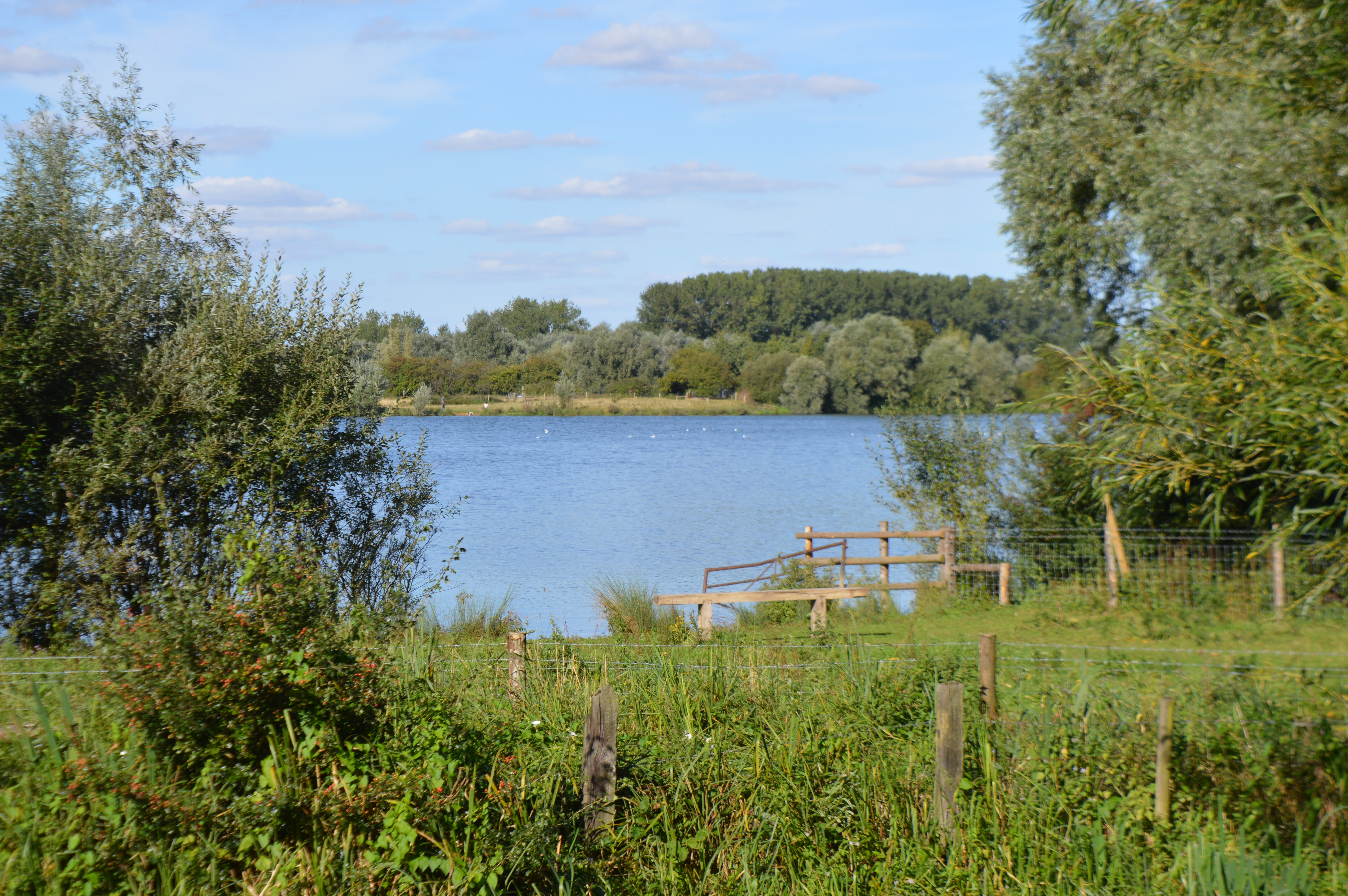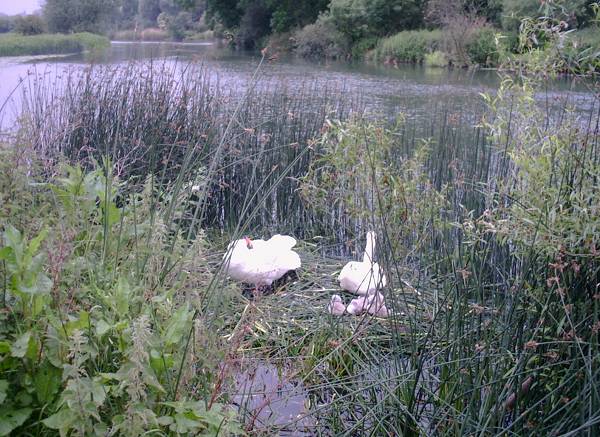|
Godmanchester Nature Reserve
Godmanchester Nature Reserve is a 59-hectare nature reserve in Godmanchester in Cambridgeshire, England. It is managed by the Wildlife Trust for Bedfordshire, Cambridgeshire and Northamptonshire. The site has four former gravel pits which are now lakes, together with areas of grassland, willow woodland and reedbeds. Birds include wigeons, tufted ducks, teals and great crested grebes, and there are insects such as dragonflies and butterflies. There is access to Island Lake and Roman Lake, but not to Peter Prince Memorial and Teddy's Lake. The Ouse Valley Way The Ouse Valley Way is a 150-mile footpath in England, following the River Great Ouse from its source near Syresham in Northamptonshire to its mouth in The Wash near King's Lynn. The path begins outside the King's Head pub in Syresham and ends o ... runs along the western edge. References {{coord, 52.329, -0.154 , type:landmark_region:GB, display=title Wildlife Trust for Bedfordshire, Cambridgeshire and Nor ... [...More Info...] [...Related Items...] OR: [Wikipedia] [Google] [Baidu] |
Godmanchester
Godmanchester ( ) is a town and civil parish in the Huntingdonshire district of Cambridgeshire, England. It is separated from Huntingdon, to the north, by the valley of the River Great Ouse. Being on the Roman road network, the town has a long history. It has a waterside location, surrounded by open countryside of high value for its biodiversity but it remains highly accessible, with a railway line to London, the A1 road and M11/ A14 which run nearby. Etymology The town was listed as ''Godmundcestre'' in the Domesday Book, and was subsequently known as ''Gutmuncetre, Gudmencestre, Gudmundcestria, Gum(m)uncestre, Gumencestre, Guncestre, Gumcestria, Gumecestre, Gommecestre, Gomecestria, Gummecestre, Gurmund(es)cestre, Gormecestre, Gormancestre, Gomecestre, Gunnecestre, Gurmecestre, Godmechestre, Gurminchestre, Gumchestre, Gurmencestre, Gumcestre, Gumestre, Godmonchestre, Gumecestur'' and ''Gumycestre''. The root itself is uncertain but the same as the town of Godalming, sugg ... [...More Info...] [...Related Items...] OR: [Wikipedia] [Google] [Baidu] |
Cambridgeshire
Cambridgeshire (abbreviated Cambs.) is a Counties of England, county in the East of England, bordering Lincolnshire to the north, Norfolk to the north-east, Suffolk to the east, Essex and Hertfordshire to the south, and Bedfordshire and Northamptonshire to the west. The city of Cambridge is the county town. Following the Local Government Act 1972 restructuring, modern Cambridgeshire was formed in 1974 through the amalgamation of two administrative counties: Cambridgeshire and Isle of Ely, comprising the Historic counties of England, historic county of Cambridgeshire (including the Isle of Ely); and Huntingdon and Peterborough, comprising the historic county of Huntingdonshire and the Soke of Peterborough, historically part of Northamptonshire. Cambridgeshire contains most of the region known as Silicon Fen. The county is now divided between Cambridgeshire County Council and Peterborough City Council, which since 1998 has formed a separate Unitary authorities of England, unita ... [...More Info...] [...Related Items...] OR: [Wikipedia] [Google] [Baidu] |
Wildlife Trust For Bedfordshire, Cambridgeshire And Northamptonshire
The Wildlife Trust for Bedfordshire, Cambridgeshire and Northamptonshire (WTBCN) is a registered charity which manages 126 nature reserves covering . It has over 35,000 members, and 95% of people in Bedfordshire, Cambridgeshire and Northamptonshire live within five miles of a reserve. In the year to 31 March 2016 it employed 105 people and had an income of £5.1 million. It aims to conserve wildlife, inspire people to take action for wildlife, offer advice and share knowledge. The WTBCN is one of 36 wildlife trusts covering England, and 46 covering the whole of the United Kingdom. In 1912 Charles Rothschild formed the Society for the Promotion of Nature Reserves to protect sites considered "worthy of preservation". The society worked to secure statutory protection, and this began with the National Parks and Access to the Countryside Act 1949. In 1959 the society took on a coordinating role for local wildlife trusts, which covered the whole of Britain and Northern Ireland by 1 ... [...More Info...] [...Related Items...] OR: [Wikipedia] [Google] [Baidu] |
Wigeon
The wigeons or widgeons are a group of birds, dabbling ducks currently classified in the genus ''Mareca'' along with two other species. There are three extant species of wigeon, in addition to one recently extinct species. Biology There are three extant species: the Eurasian wigeon (''Mareca penelope''), the American wigeon (''M. americana'') and the Chiloé wigeon (''M. sibilatrix''). A fourth species, the Amsterdam wigeon (''Mareca marecula''), became extinct in the 19th century. The wigeons' closest relatives, forming with them the genus ''Mareca'', are the gadwall and the falcated duck. All three wigeons are similarly shaped, with a steep forehead and bulbous rear to the head. Males have a distinctive breeding plumage, in their eclipse plumage Plumage ( "feather") is a layer of feathers that covers a bird and the pattern, colour, and arrangement of those feathers. The pattern and colours of plumage differ between species and subspecies and may vary with age classes. ... [...More Info...] [...Related Items...] OR: [Wikipedia] [Google] [Baidu] |
Tufted Duck
The tufted duck or tufted pochard (''Aythya fuligula'') is a small diving duck with a population of close to one million birds, found in northern Eurasia. The scientific name is derived from Ancient Greek '' aithuia'', an unidentified seabird mentioned by authors including Hesychius and Aristotle, and ''Latin'' ''fuligo'' "soot" and ''gula'' "throat". Description The adult male is all black except for white flanks and a blue-grey bill with gold-yellow eyes, along with a thin crest on the back of its head. It has an obvious head tuft that gives the species its name. The adult female is brown with paler flanks, and is more easily confused with other diving ducks. In particular, some have white around the bill base which resembles the scaup species, although the white is never as extensive as in those ducks. The females' call is a harsh, growling "karr", mostly given in flight. The males are mostly silent but they make whistles during courtship based on a simple "wit-oo". The onl ... [...More Info...] [...Related Items...] OR: [Wikipedia] [Google] [Baidu] |
Teal
alt=American teal duck (male), Green-winged teal (male) Teal is a greenish-blue colour. Its name comes from that of a bird — the Eurasian teal (''Anas crecca'') — which presents a similarly coloured stripe on its head. The word is often used colloquially to refer to shades of cyan in general. It can be created by mixing cyan into a green base, or deepened as needed with black or grey. The complementary colour of teal is pink. It is also one of the first group of 16 HTML/CSS web colors formulated in 1987. In the RGB model used to create colours on computer screens and televisions, teal is created by reducing the brightness of cyan to about one half. Teal was a fad colour during the 1990s, with, among others, many sports teams adopting the colour for their uniforms. Etymology The first recorded use of ''teal'' as a colour name in English was in 1917. The term ''teal'' (referring to a sort of duck) is derived from the Middle English ''tele'', a word akin to the Dutc ... [...More Info...] [...Related Items...] OR: [Wikipedia] [Google] [Baidu] |
Great Crested Grebe
The great crested grebe (''Podiceps cristatus'') is a member of the grebe family of water birds noted for its elaborate mating display. Taxonomy The great crested grebe was formally described by the Swedish naturalist Carl Linnaeus in 1758 in the tenth edition of his ''Systema Naturae'' under the binomial name ''Colymbus cristatus''. The great crested grebe is now the type species of the genus ''Podiceps'' that was erected by the English naturalist John Latham in 1787. The type locality is Sweden. The scientific name comes from Latin: the genus name ''Podiceps'' is from , "vent" and , "foot", and is a reference to the placement of a grebe's legs towards the rear of its body; the species name, ''cristatus'', means "crested". Three subspecies are recognised: * ''P. c. cristatus'' (Linnaeus, 1758) – Eurasia * ''P. c. infuscatus'' Salvadori, 1884 – Africa * ''P. c. australis'' Gould, 1844 – Australia, Tasmania, South Island of New Zealand Description The great creste ... [...More Info...] [...Related Items...] OR: [Wikipedia] [Google] [Baidu] |
Ouse Valley Way
The Ouse Valley Way is a 150-mile footpath in England, following the River Great Ouse from its source near Syresham in Northamptonshire to its mouth in The Wash near King's Lynn. The path begins outside the King's Head pub in Syresham and ends on the Green Quay in King's Lynn There is a long-term plan to complete remaining gaps in the path, meanwhile it is possible to walk the entire route, although in places the footpath and river temporarily part company. The route passes many interesting places and there is much to see, including attractive countryside, pretty villages, ancient English market towns, churches and a cathedral, and abundant wildlife. Towns from source to mouth include Buckingham, Milton Keynes, Olney, Bedford, St Neots, Huntingdon, St Ives, Ely, Downham Market, and King's Lynn. The route is way-marked and maintained by The Countryside Agency who also provide maps and written guides online. A small section of the Ouse Valley Way is used on the Pathfinder ... [...More Info...] [...Related Items...] OR: [Wikipedia] [Google] [Baidu] |
Wildlife Trust For Bedfordshire, Cambridgeshire And Northamptonshire Reserves
Wildlife refers to undomesticated animal species, but has come to include all organisms that grow or live wild in an area without being introduced by humans. Wildlife was also synonymous to game: those birds and mammals that were hunted for sport. Wildlife can be found in all ecosystems. Deserts, plains, grasslands, woodlands, forests, and other areas, including the most developed urban areas, all have distinct forms of wildlife. While the term in popular culture usually refers to animals that are untouched by human factors, most scientists agree that much wildlife is affected by human activities. Some wildlife threaten human safety, health, property, and quality of life. However, many wild animals, even the dangerous ones, have value to human beings. This value might be economic, educational, or emotional in nature. Humans have historically tended to separate civilization from wildlife in a number of ways, including the legal, social, and moral senses. Some animals, h ... [...More Info...] [...Related Items...] OR: [Wikipedia] [Google] [Baidu] |
.jpg)



.jpg)